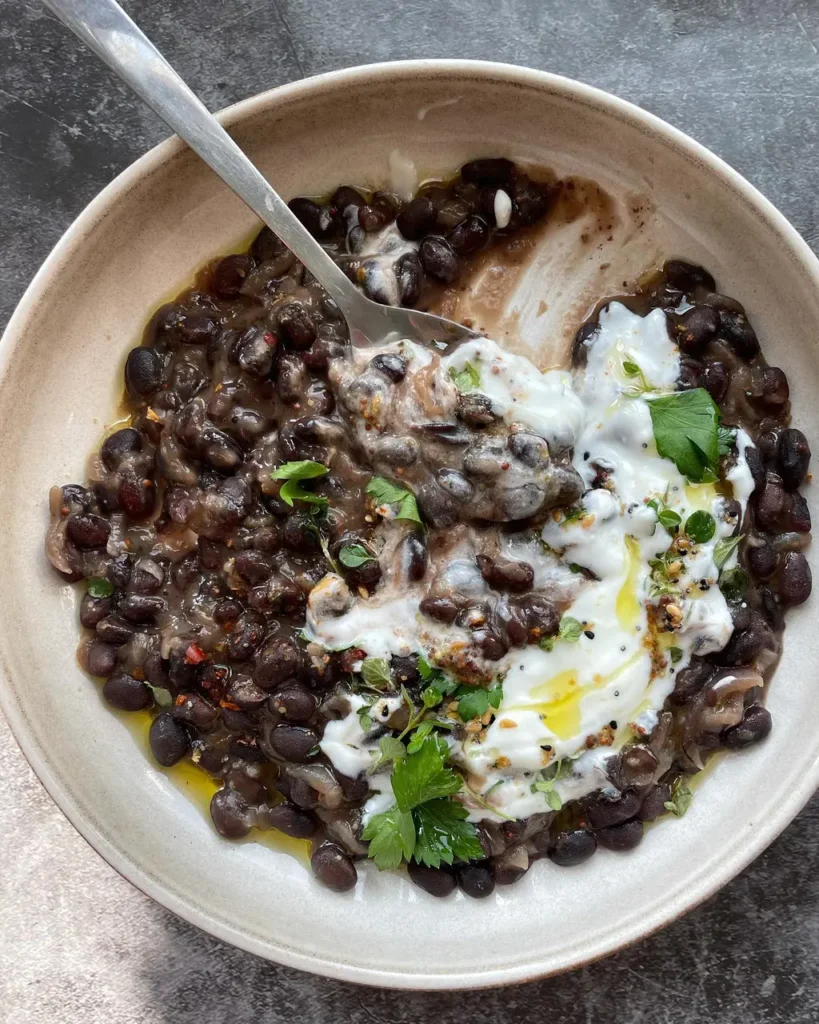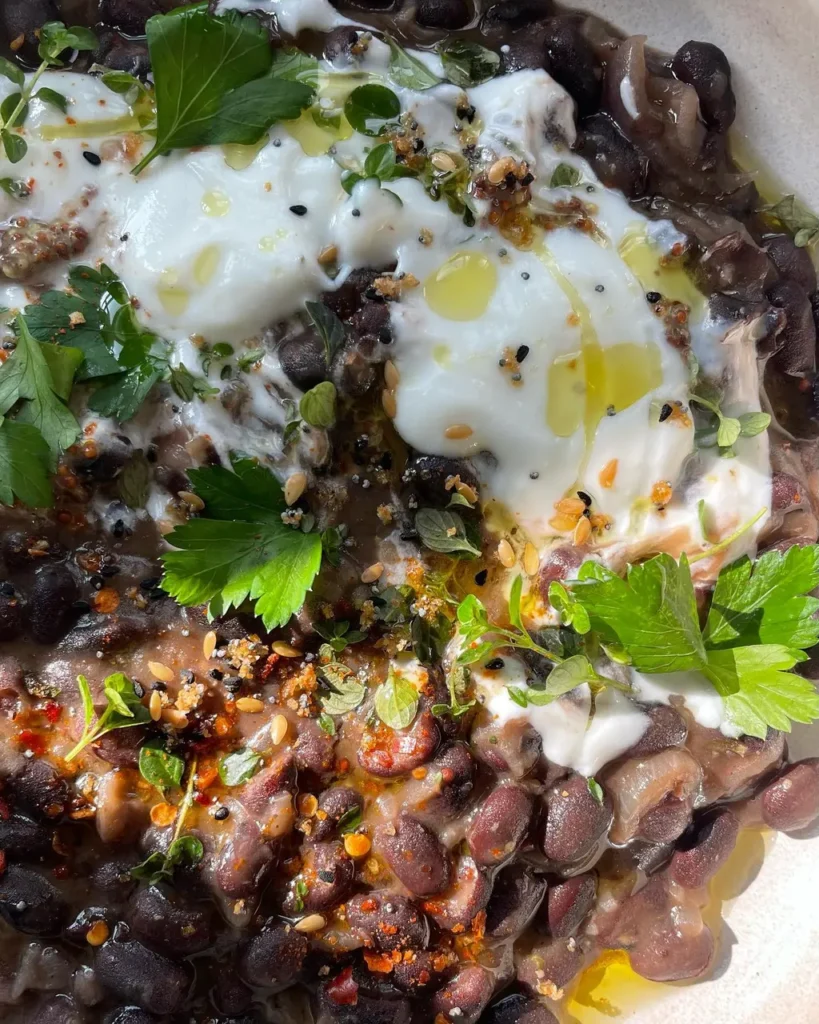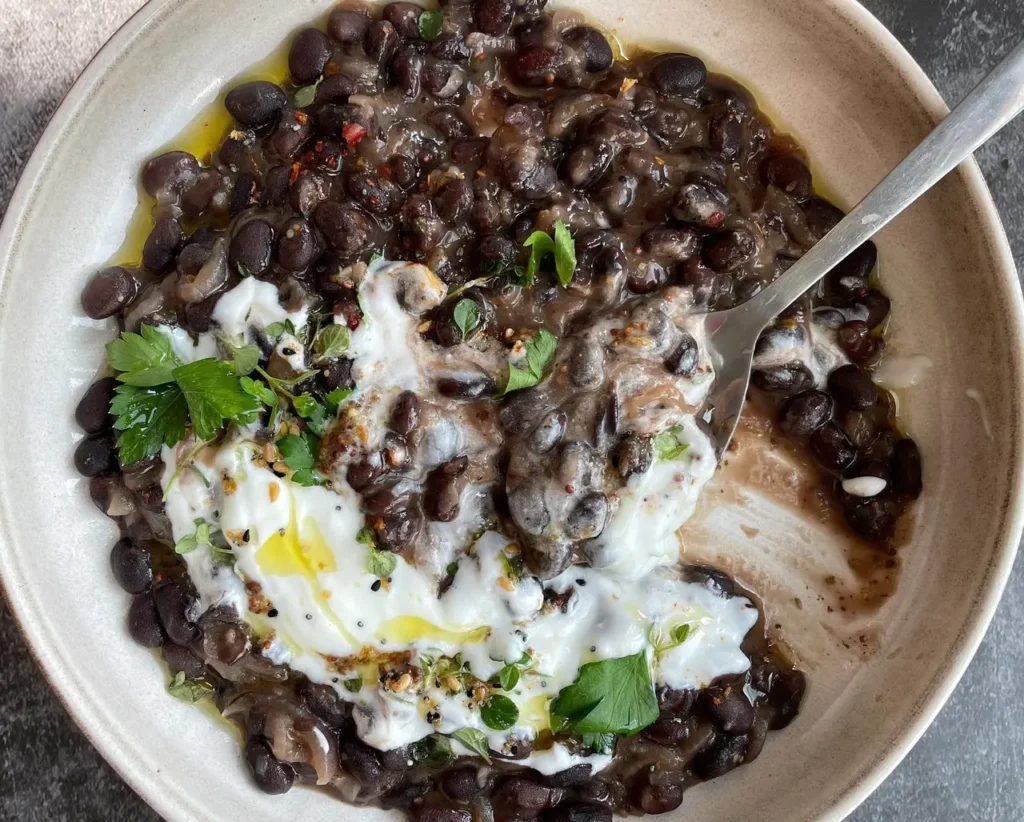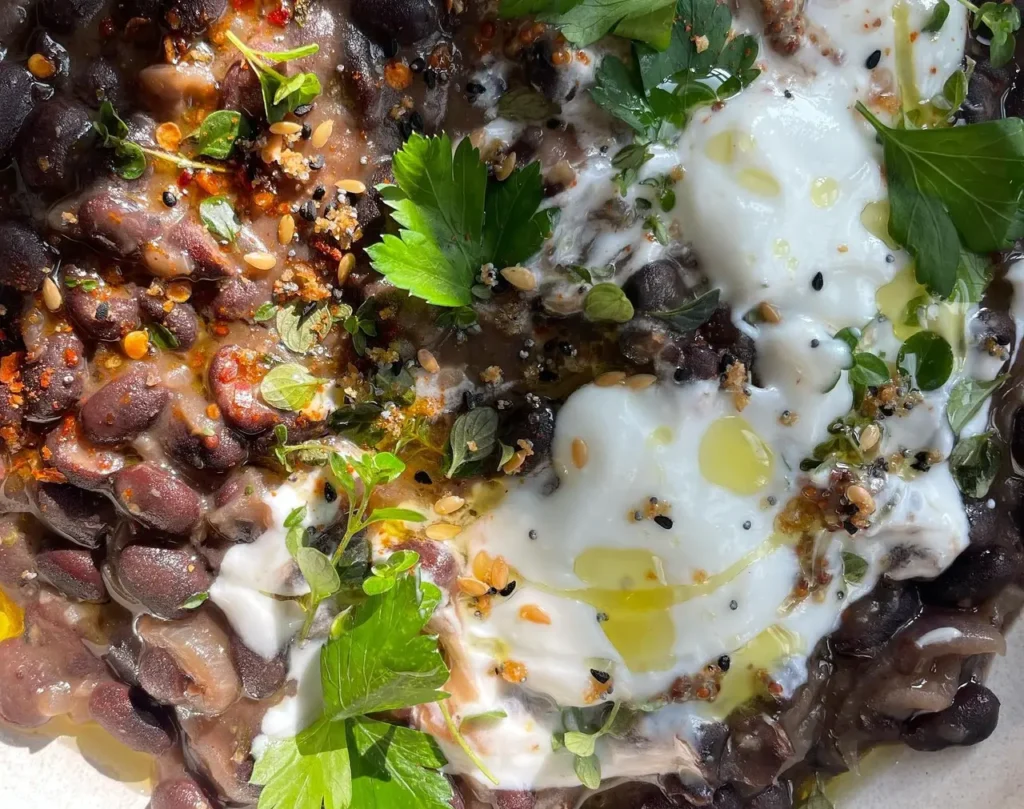Many simple bean stews can taste plain or one-dimensional. This caramelized onion and black bean stew is the complete opposite—deeply savory, rich, and comfortingly hearty.
The slow-cooked onions melt into a sweet, golden base that’s balanced by earthy black beans, a splash of tangy balsamic, and subtle warmth from wholegrain mustard.
It’s a dish that feels gourmet while using only humble pantry staples—and it’s budget-friendly, nourishing, and perfect for chilly nights.
Ready in just a few steps, this stew is proof that comfort food doesn’t need to be complicated. Pair it with warm bread, fluffy rice, or even spooned over creamy parmesan polenta with peas and eggs for a soul-satisfying meal that everyone at the table will crave again and again.
The Magic of Caramelized Onions
Caramelized onions are the heart of this recipe. When cooked low and slow, onions undergo a natural transformation—their sharpness softens, their sugars concentrate, and their color deepens into a glossy bronze. The result is pure umami magic.
Patience is key here. Give the onions at least 30 to 40 minutes to truly break down. Stir occasionally, letting them stick just a little before loosening with a splash of water. That slight stickiness builds flavor.
If you love that deep caramel flavor, try incorporating caramelized onions into other dishes too, like a creamy mushroom pasta or a charred broccoli and quinoa bowl. Once you start, you’ll want to add them to everything.
Building Flavor with Pantry Staples
This stew may be minimal in ingredients, but each one plays a vital role in creating balance and depth.
Soy sauce introduces saltiness and savory complexity, enhancing the onion’s sweetness.
Balsamic vinegar brings acidity, cutting through richness and adding a dark fruit-like tang.
Wholegrain mustard adds texture, gentle heat, and a nutty sharpness that rounds everything out.
A few sprigs of fresh thyme infuse subtle herbal notes that echo through every bite.
Combined, these pantry staples form a powerful foundation that makes the stew taste like it simmered all day—even if you made it after work.
The Star Ingredient: Black Beans

Black beans are one of the most versatile ingredients in plant-based cooking. They’re packed with protein, fiber, and a mild earthiness that complements the sweetness of caramelized onions beautifully.
For this recipe, you can use jarred or canned black beans—just make sure they’re tender and high-quality. If your beans come packed in a thick broth, that’s even better; it’ll add more depth to the stew. If they’re in water, simply supplement with a bit of vegetable stock to enrich the base.
Black beans absorb surrounding flavors effortlessly, which is why they shine in slow-simmered recipes like this. Over time, the beans take on the tang of balsamic, the smokiness of soy, and the aromatic touch of thyme.
A Slow Simmer for Maximum Comfort
After caramelizing your onions and adding the flavoring ingredients, the magic happens during the slow simmer.
Letting the stew bubble gently for about an hour allows everything to come together. The onions dissolve into the beans, thickening the sauce naturally—no need for cream or cornstarch. The thyme releases its oils slowly, and the soy-mustard-balsamic combination mellows into a perfectly balanced broth.
This step is also when you can adjust the consistency. If you like a thicker stew, simmer uncovered for the last 10–15 minutes to let it reduce. If you prefer it soupier, add a splash of hot water or vegetable stock toward the end.
Serving Suggestions for the Ultimate Bowl

The beauty of this caramelized onion and black bean stew is its versatility. You can serve it as-is or dress it up depending on the occasion.
For a light meal, ladle it into bowls and top with a generous dollop of natural yogurt (or a dairy-free alternative). The cool creaminess offsets the stew’s richness perfectly. A drizzle of olive oil and a sprinkle of fresh parsley complete the look—and add freshness to every spoonful.
If you’re after something heartier, serve the stew over fluffy white rice or creamy parmesan polenta with peas and eggs. The grains soak up all that luscious sauce, turning it into a full, comforting meal.
It also pairs beautifully with smoky paprika sweet potato flatbreads or crusty sourdough baguettes for dipping. Each bite becomes a warm, satisfying experience.
Variations You’ll Love
What makes this recipe so adaptable is how easy it is to customize. You can tweak it based on what’s in your pantry or the flavor profile you’re craving.
For a smoky twist, add a pinch of smoked paprika or a little chipotle paste. It’ll add a subtle heat that pairs beautifully with the sweetness of the onions.
For extra protein, stir in shredded cooked chicken or crumbled tofu near the end of cooking.
You can even turn it into a thicker filling for wraps or burritos by reducing the broth and mashing part of the beans. It’s an incredible meal prep idea—make one big pot and repurpose it throughout the week.
Why This Stew Works So Well

This recipe might look simple, but it’s a masterclass in layering flavors. Each ingredient is carefully chosen to support the others.
The slow caramelization adds sweetness.
The soy and balsamic add savory depth and acidity.
The mustard sharpens and brightens.
The thyme weaves everything together with aromatic elegance.
It’s a perfect balance of sweet, salty, tangy, and earthy—all achieved with minimal effort.
It’s also naturally vegetarian, high in fiber, and easy to make gluten-free by checking your soy sauce.
That makes it an ideal weekday dinner that feels indulgent but supports a wholesome, balanced diet.
Make-Ahead, Storage, and Reheating Tips
This stew is one of those dishes that actually gets better with time. The flavors deepen overnight, making it an ideal make-ahead meal.
Once cooled, store leftovers in an airtight container in the fridge for up to four days. When reheating, do it gently over medium heat, adding a splash of water or stock if it thickens too much.
You can also freeze it for up to three months. Just portion it into containers, leave some space for expansion, and thaw overnight before reheating.
If you’re planning a cozy dinner party, make the stew a day ahead—it reheats beautifully, and you’ll love how much richer it tastes the next day.
Tips for Perfect Caramelization Every Time

To master caramelized onions, here are a few helpful tricks:
Start with low to medium heat. Too high, and they’ll burn instead of caramelize.
Use a wide, heavy-bottomed pan so the onions have space to cook evenly.
Stir occasionally, not constantly. Letting them sit undisturbed for a few minutes encourages proper browning.
If they begin to stick, deglaze with a splash of water or stock and scrape up the browned bits—they’re packed with flavor.
With these small adjustments, you’ll create golden, jammy onions that make the base of this stew irresistible.
A Cozy Favorite All Year Round
While it’s especially satisfying in autumn and winter, this stew works beautifully year-round. Its earthy warmth makes it ideal for chilly evenings, but its light, plant-based nature means it doesn’t feel heavy even in spring.
It’s also a fantastic recipe for meal planning, vegetarian hosting, or budget-friendly cooking. A few onions and a couple of cans of beans turn into a dish that feels refined enough for company yet simple enough for a quiet weeknight.
If you enjoy comforting bowls like this, you might also love creamy sundried tomato chickpeas or Persian chicken with chickpeas for a different twist on hearty one-pot meals.
Frequently Asked Questions
Can I use other beans instead of black beans?
Yes, kidney beans or pinto beans work well too. They’ll have a slightly different texture, but they absorb flavor beautifully.
Can I make this recipe vegan?
Absolutely. Just swap the natural yogurt topping with a dairy-free yogurt or omit it entirely. The stew itself is fully plant-based.
What can I serve alongside this stew?
It’s delicious with rice, quinoa, couscous, or crusty bread. For an extra cozy pairing, try it with creamy Turkish poached eggs or a flourless oatmeal bread slice.
Can I add vegetables?
Definitely. Carrots, celery, bell peppers, or even spinach can be stirred in for more texture and nutrition. Add firmer veggies early and leafy greens at the end.
Why is my stew too thick or too thin?
If it’s too thick, stir in a little more water or vegetable stock. If it’s too thin, simmer uncovered for a few extra minutes to reduce.
Is this stew spicy?
No—it’s mild and balanced. But if you want some heat, a pinch of chili flakes or smoked paprika does wonders.
This caramelized onion and black bean stew is more than a meal—it’s a warm hug in a bowl. With simple ingredients, minimal effort, and deep, comforting flavor, it’s a dish that feels both homely and elevated. Once you’ve tasted how the sweetness of onions meets the heartiness of beans, it’ll become a regular part of your cozy-night cooking rotation.
For more hearty comfort recipes, try exploring one-pot French onion beef and noodles or creamy kale garlic pasta with lemon—each one carries that same cozy, flavor-forward spirit that makes simple ingredients shine.

Caramelized Onion and Black Bean Stew
Ingredients
Method
- Heat olive oil in a large deep saucepan over low to medium heat. Add the sliced onions and cook slowly for about 30 minutes, stirring occasionally, until soft, golden, and caramelized.
- Add the soy sauce, balsamic vinegar, wholegrain mustard, and thyme sprigs. Stir well and continue cooking for another 15 minutes until the flavors deepen.
- Add the black beans and pour in vegetable stock (or water if using jarred beans with stock). Stir to combine, then bring to a gentle simmer.
- Let the stew simmer uncovered for about 60 minutes on low heat, stirring occasionally. The onions should melt into the sauce, creating a thick and rich consistency.
- Taste and adjust seasoning if needed. Remove thyme sprigs before serving.
- Serve warm in bowls topped with a spoonful of natural yogurt, chopped parsley, and a drizzle of olive oil.
Notes
- Caramelize the onions slowly for a rich, sweet flavor. Don’t rush this step.
- The stew thickens as it cools—add a splash of stock when reheating if needed.
- For a vegan version, use plant-based yogurt instead of dairy.
- This stew tastes even better the next day after the flavors deepen overnight.


Leave a Reply